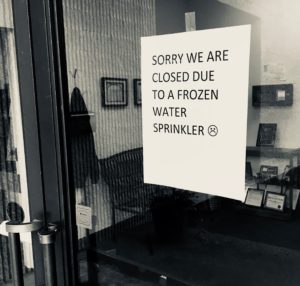Cold Weather Protection
Cold weather can impact your sprinkler system any time temperatures are below 40° Fahrenheit and water is present. NFPA 25, Standard for the Inspection, Testing, and Maintenance of Water Based Fire Protection Systems, recognizes the need for building owners/occupants to take proactive measures prior to the onset of freezing weather. The following code references actions to be taken:
Annually, prior to the onset of freezing weather, buildings with wet pipe sprinkler systems shall be inspected to verify that windows, skylights, doors, ventilators, other opening and closures, blind spaces, unused attics, stair towers, roof houses, and low spaces under buildings do not exposed water filled sprinkler piping to freezing and to verify the adequate heat is available. – NFPA 25, Section 5.2.5
9 Steps to Prepare for the Cold Weather:
- Keep doors, windows, and vents closed when not in use or when resulting drafts will allow subfreezing air to contact sprinkler piping.
- Keep thermostats set at 55° F or above.
- Inspect attic spaces to ensure sprinkler pipe is adequately insulated.
- Check the integrity of the exterior building envelope. Caulk cracks and seal openings that might permit cold air to infiltrate the building.
- When drop ceilings are used, remove strategically placed ceiling tiles to allow extra heat into the opened area.
- Antifreeze solutions, if used, should be tested in order to determine product stability and level of protection.
- Drain any water or condensate from auxiliary drains and all low point drains. These drains are also commonly referred to as drum drip valves.
- Be sure that the dry pipe valve and riser are in a heated area.
- Electronically monitor and visually inspect the air pressure and temperature in the dry pipe valve riser room.
Contact us for more information! We are here to help.


